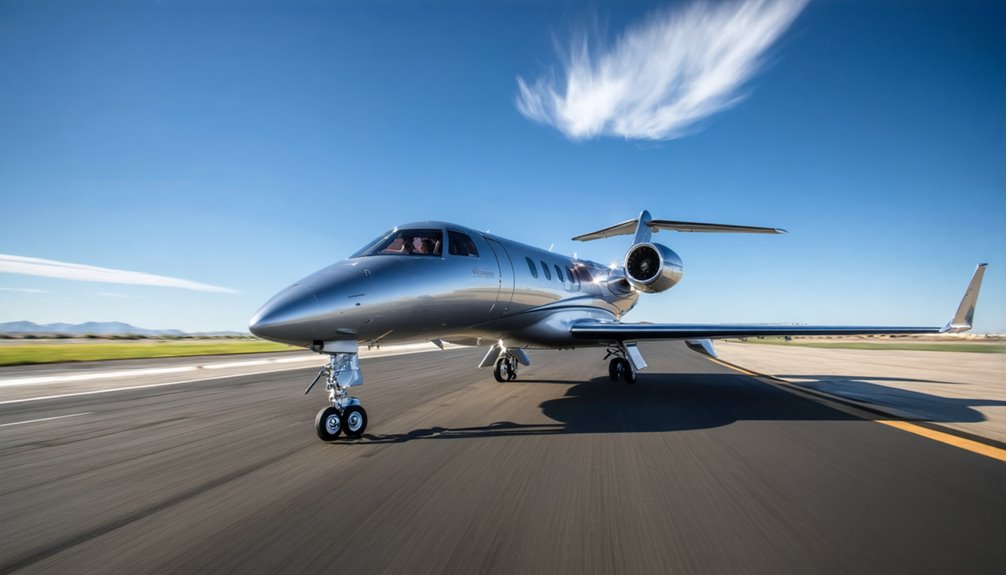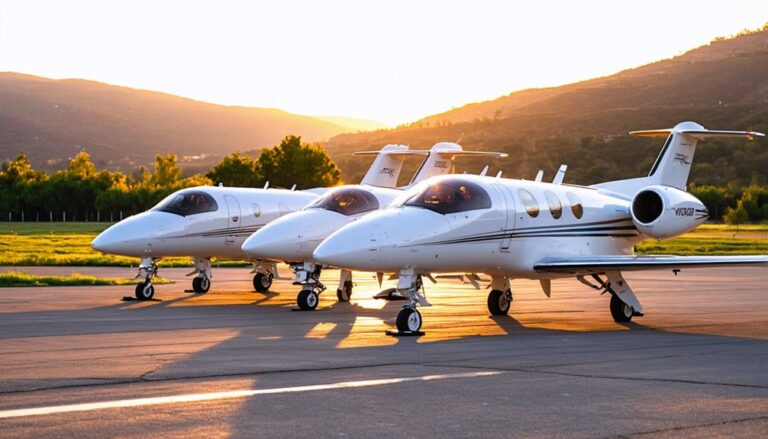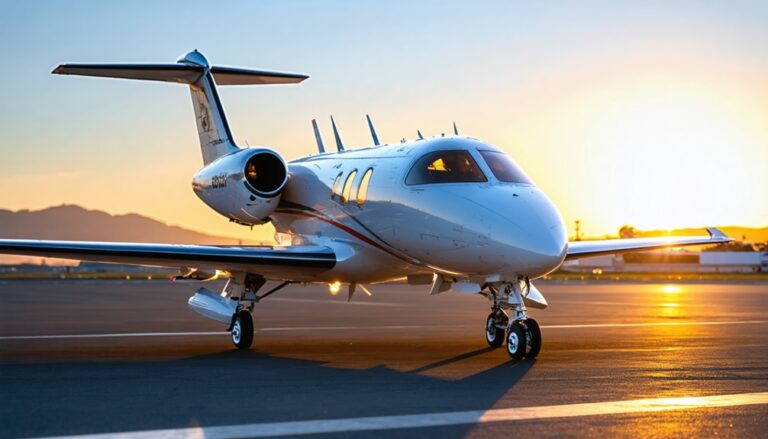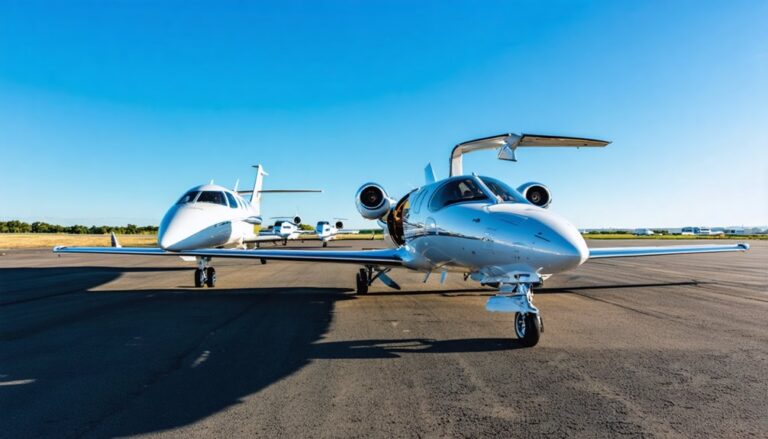Advantages of Renting a Light Jet for Business Travel
Renting a light jet for business travel offers great advantages like flexibility and efficiency. You can skip long security lines and fly when it suits you, which saves precious time. Light jets can access more than 5,000 airports that commercial airlines cannot reach. This means you can land closer to your destination.
The private cabin of a light jet creates a safe space for important conversations, making it easier to discuss confidential matters. Plus, most light jets come equipped with high-speed Wi-Fi, allowing you to work continuously while in the air.
The cost to rent a light jet typically ranges from $2,500 to $5,500 per hour. For teams that fly fewer than 200 times a year, the benefits of speed and convenience often outweigh the costs. In today’s fast-paced business world, having access to a light jet can be a game-changer for effective travel.
Key Takeaways
Renting light jets is a smart choice for business travel. It cuts down on costs. You avoid spending between $1 million and $5 million for the initial purchase. Plus, you don’t have to worry about annual maintenance fees.
Time is valuable. With light jets, you can take off right away. These jets can land at smaller airports, which means you can reach more locations in a single day. This efficiency helps you make the most of your travel schedule.
Private cabins are another perk. They provide a quiet space for confidential discussions. High-speed internet keeps you connected, allowing you to work effectively while in the air.
Flexibility is key. You can choose your departure time, often with options for same-day bookings. If plans change, adaptable cancellation policies make it easier.
Finally, light jets impress clients and also help the environment. They consume less fuel than larger aircraft, making them a greener option for business travel.
Time Efficiency: Maximizing Your Business Schedule
In today’s fast-paced business world, light jets offer significant advantages for anyone looking to maximize time efficiency. These aircraft provide a convenient alternative to commercial flights, eliminating many of the delays and frustrations associated with air travel.
With the ability to depart when you choose, you can take off as soon as you’re ready. Light jets cruise at speeds of 400-500 mph, enabling swift travel. For instance, a flight from New York to Miami takes just about two hours, turning what could be a long journey into a quick, productive trip.
One standout feature of light jets is their access to smaller airports. This means you can land closer to your final destination, significantly reducing the time spent on the ground. You avoid long security lines and the hassle of layovers.
Instead, you arrive feeling refreshed and on time, making a positive impression on clients. This level of control over your schedule provides a rare sense of freedom in the busy landscape of modern business.
Cost Analysis: When Light Jets Make Financial Sense
Many business leaders think private aviation is too costly. However, a thorough cost analysis shows that renting a light jet can be a wise financial choice. Chartering a jet removes the heavy burden of ownership costs. You don’t have to worry about huge upfront payments or ongoing upkeep expenses that can drain your finances.
| Expense Category | Ownership | Charter |
|---|---|---|
| Initial Cost | $1M-$5M | $0 |
| Annual Maintenance | $500,000+ | $0 |
| Hourly Operating Cost | Fixed | $2,500-$5,500 |
| Insurance/Depreciation | High | None |
| Aircraft Flexibility | Limited | Unlimited |
If you fly less than 200 hours a year, renting is often cheaper. You have the freedom to choose the right aircraft for each trip. You also avoid the depreciation and fixed costs that come with owning a jet. This smart decision allows you to redirect savings into your main business activities.
Light jets, known for their efficiency and range, are ideal for short to medium distances. They can carry up to 8 passengers comfortably. Their speed and lower operating costs make them a great option for many travelers. By chartering a light jet, you enjoy luxury and convenience without the financial strain of ownership.
Enhanced Privacy for Confidential Business Discussions

In the world of private aviation, light jets stand out as a practical choice for business executives. These jets offer exclusive access, allowing teams to travel together in a private setting. This setup fosters a space where important discussions can happen without the worry of prying ears.
Flying on a light jet is different from commercial flights. On those, travelers often deal with crowded spaces and potential eavesdroppers. Light jets provide a calm atmosphere where sensitive negotiations can take place. Whether it’s reviewing confidential documents or brainstorming strategies, executives can focus without distractions.
The benefits of light jets go beyond the interior. You avoid busy terminals and long security lines. This means your team can travel discreetly, maintaining privacy from the moment they arrive at the airport until they land at their destination.
With customizable interiors, light jets also allow teams to convert travel time into valuable meeting space. In a world where information security is crucial, this level of privacy isn’t just a luxury; it’s a necessity.
Productivity Benefits During Transit
Light jets offer a remarkable way to enhance productivity during travel. When I rent a light jet, I create a focused workspace high above the ground. This setting allows me to tackle important projects without distractions from other travelers. In essence, I turn travel hours into valuable work time.
These jets, known for their speed and efficiency, come equipped with high-speed internet. This feature ensures I can keep my business operations running smoothly. I can quickly reply to urgent emails, access necessary documents stored in the cloud, and even hold video calls while flying at 40,000 feet.
The convenience of light jets means you don’t waste time in long security lines or crowded terminals. Instead, you can board swiftly, settle into a comfortable seat, and start working right away.
With this combination of speed, connectivity, and comfort, light jets truly transform the way we view travel, making it a productive part of our business journey.
Distraction-Free Workspace
Traveling for business on commercial airlines can be tough. It’s hard to focus with the constant noise, chatter, and cramped seats. Light jets change that. They create a peaceful workspace that lets you turn travel time into productive time.
When you choose to charter a light jet for business, you get several benefits. First, you enjoy a quiet space. This allows you to dive deep into important documents without distractions.
Second, light jets provide a private area for meetings. This means sensitive conversations stay confidential.
Third, you have access to high-speed Wi-Fi. This keeps you connected and able to handle urgent matters.
Finally, you control your environment. You can avoid the usual stress that comes with flying commercial.
This calm atmosphere boosts your focus. It also helps you prepare mentally for meetings. You gain an advantage that you simply can’t find in commercial settings.
Real-Time Business Continuity
Business continuity doesn’t stop when you take to the skies. Light jets, known for their efficiency and speed, have transformed how traveling executives work. These nimble aircraft offer a focused environment, allowing you to tackle important tasks without the usual interruptions found on commercial flights.
High-speed Wi-Fi on these jets keeps you connected to your team, clients, and stakeholders in real-time. Many business travelers appreciate the chance to have private meetings without worrying about eavesdropping. This ensures that sensitive conversations remain confidential.
Plus, light jets soar at higher altitudes, which often leads to a smoother ride and less turbulence, so you can maintain your productivity throughout the flight.
Light jets, such as the Embraer Phenom 300 and the Cessna Citation M2, are popular choices. They’re designed for short to medium distances, making them perfect for quick trips.
With their spacious cabins and comfortable seating, they allow you to work, relax, or prepare for your next meeting. In the world of business, time is money, and light jets help you make the most of both.
Access to Remote Business Locations
When you’re in a competitive market, getting to remote business locations can be critical.
Light jets are a game-changer for corporate travel. They can land at over 5,000 smaller airports in the U.S. that commercial flights can’t reach. This ability can help you secure valuable contracts and seize opportunities.
With a light jet, you can land closer to your destination instead of hours away at a major airport. You also have the flexibility to create flight schedules that fit your needs, not the airline’s. This means you can visit multiple remote locations in one day, boosting your productivity.
Moreover, light jets can connect you to underserved business sites that your competitors may find hard to access.
Because light jets need shorter runways, they can touch down at small airstrips near your actual business location. This capability changes long, tedious trips into strategic advantages that can put you ahead in the market.
Flexibility in Departure and Arrival Times
When you choose a light jet for your travel, you gain total control over your itinerary. Unlike commercial flights with strict schedules, light jets let you pick your departure and arrival times. This flexibility can change how you approach business travel. You can act quickly on opportunities without the usual delays.
| Benefit | Commercial Flights | Charter Flights |
|---|---|---|
| Schedule Control | Fixed timetables | Your chosen times |
| Booking Lead Time | Weeks in advance | Same-day possible |
| Airport Options | Major hubs only | Smaller, convenient airports |
| Multi-Stop Capability | Limited, complex | Multiple cities in one day |
Using a light jet can save you a lot of time. You won’t waste hours in crowded terminals or need overnight stays between meetings. Instead, you can stay productive. If a meeting runs long, you can adjust your departure time. You won’t face the limitations of traditional airlines.
Light jets are perfect for short trips, often seating 6 to 8 passengers. They can access smaller airports, getting you closer to your final destination. This makes them ideal for business travelers needing to visit multiple locations in one day.
Reduced Travel Fatigue for Executive Teams
Light jets are a smart choice for executive teams looking to travel efficiently. These aircraft fly at higher altitudes, usually between 30,000 and 40,000 feet. This altitude helps avoid the turbulence that often disrupts commercial flights. As a result, your team arrives feeling refreshed and ready to tackle meetings.
Travel time is significantly reduced with light jets. For example, a trip from New York to Miami takes only two hours. In contrast, commercial flights can involve long layovers and delays.
Inside a light jet, you’ll find spacious seating. With fewer passengers on board, the atmosphere is calm and quiet. This setup allows team members to prepare for their work or unwind after the flight.
In-flight amenities enhance the travel experience. Many light jets offer Wi-Fi, allowing passengers to stay connected. Customized meals cater to individual preferences, whether that’s for productivity or relaxation.
Light jets also provide access to smaller airports that are closer to final destinations. This feature cuts down on the time spent in ground transportation, making the journey even smoother.
Choosing light jets not only supports operational efficiency but also prioritizes the well-being of your executive team.
Customized Onboard Services for Business Needs
Light jets are great for business travel. They offer onboard services that turn flight time into productive hours. High-speed Wi-Fi is a standout feature. It lets you hold video calls and access important documents while you fly.
The interiors of light jets are designed for work. Comfortable seats and adjustable climate control help keep your team focused. Flight attendants are attentive and ready to meet your needs. They ensure your discussions stay private and serve gourmet meals tailored to your preferences.
A light jet isn’t just a way to get from point A to point B. It acts as a valuable business tool. Refreshment centers stocked with your favorite drinks and snacks enhance the work atmosphere.
Every mile flown is a step towards achieving your business goals.
Environmental Considerations of Light Jet Travel
Light jets have unique characteristics that make them stand out in the world of private aviation. They’re smaller and lighter than larger jets, which means they use less fuel per trip. This lower fuel consumption helps to decrease greenhouse gas emissions.
One impressive aspect of light jets is their ability to access smaller airports. Commercial airlines often fly to major hubs, leaving many smaller locations underserved. Light jets can land at these airports, making travel more efficient and convenient for passengers.
The aviation industry is moving toward greener practices. Many companies are exploring sustainable aviation fuels, which can significantly reduce the carbon footprint of flights. Furthermore, advancements in engine technology are making these jets more efficient.
This combination of factors is aligning private aviation with corporate sustainability goals.

Reduced Per-Passenger Emissions
Light jets are an excellent choice for eco-friendly business travel. They’ve lower per-passenger emissions, making them more appealing for executives who prioritize sustainability. When I opt for a light jet, I’m choosing efficiency while caring for the environment.
These nimble aircraft usually accommodate up to seven passengers, which significantly reduces the carbon footprint for each traveler. Light jets consume around 100 gallons of fuel per hour. This is much less than larger planes.
They’re most fuel-efficient when cruising at altitudes of 30,000 to 40,000 feet, where the air is smoother and turbulence is minimal.
Another advantage is the growing use of sustainable aviation fuel. This type of fuel helps lower the environmental impact of flying.
Moreover, when a light jet flies with a full passenger load, the per-passenger emissions decrease even further. This makes light jets a smart choice for those who want to travel responsibly.
Efficient Fuel Consumption
When looking at private aviation, fuel consumption is a key concern for eco-friendly travelers. Light jets are a standout option. They are efficient for business travel, using only 100 to 250 gallons of fuel per hour. In comparison, larger jets consume significantly more fuel.
Here’s a quick look at different types of private jets:
| Aircraft Type | Fuel Efficiency | Environmental Impact | Cost Savings | Range Capability |
|---|---|---|---|---|
| Light Jets | 100-250 gal/hr | Lower emissions | Significant | 1,000-2,000 miles |
| Mid-size Jets | 250-350 gal/hr | Moderate emissions | Average | 2,000-3,000 miles |
| Heavy Jets | 350-500+ gal/hr | Higher emissions | Minimal | 3,000-6,000 miles |
| Turboprops | 80-110 gal/hr | Very low emissions | Highest | 800-1,500 miles |
| Commercial Jets | 750-900 gal/hr | High per-aircraft emissions | N/A | 3,000+ miles |
Light jets excel in fuel efficiency and have a lower environmental impact. They are perfect for business travelers who value mobility without harming the planet. Advanced aerodynamics and modern engine technology contribute to this efficiency.
Choosing a light jet means making a responsible choice for both personal travel and the environment. Whether you aim for quick business trips or luxury travel, light jets offer a smart solution.
Smaller Airport Accessibility
Light jets are an excellent choice for eco-conscious travelers. They can land at smaller, regional airports, which helps the environment. When I fly on a light jet for business, I not only save time but also lessen my carbon footprint. These jets allow me to land closer to my destination, which means I use less ground transportation and avoid the pollution created by busy airports.
Smaller airports handle passengers more quickly. This reduces the time jets spend idling on the tarmac, which cuts down on energy use. Additionally, regional airfields often have shorter taxi routes. This means less fuel is burned before takeoff and after landing.
Light jets are designed for efficiency, especially on shorter trips, making them ideal for regional operations. By choosing light jets, we help spread out air traffic. This reduces the heavy environmental impact on major city centers. Collectively, these choices make a difference in preserving our planet.
Safety Advantages for Corporate Travelers
Corporate travelers focused on their wellbeing should consider light jets for their safety benefits. Light jets stand out from commercial flights when it comes to security. Reputable charter companies keep excellent safety records. They conduct thorough aircraft maintenance and regular inspections, meeting the same safety standards as commercial airlines.
Selecting a reliable jet charter partner brings peace of mind. Highly skilled pilots operate advanced navigation systems. Real-time weather monitoring helps ensure a smooth journey.
Trust our pilots and technology to navigate you safely through the skies with expert precision.
Light jets usually carry fewer passengers, which lowers the risk of exposure to illnesses compared to crowded commercial flights.
Traveling by light jet also means avoiding the safety issues of busy airports. Instead, you can access smaller airfields. These locations have less congestion and shorter security lines, making your travel experience more efficient.
Technological Connectivity in the Air
Light jets have become popular for both business and leisure travel due to their efficiency and advanced technology. These aircraft offer a unique combination of speed and comfort, making them ideal for short to medium-distance trips.
One of the standout features of light jets is their technological connectivity. At cruising altitudes, many jets provide high-speed Wi-Fi. This means you can stay connected to emails and important updates while flying. Satellite communication systems keep you informed about current events, so you can make decisions on the go.
Inside the cabin, you’ll find power outlets and USB ports at every seat. This ensures that you can keep your devices charged and ready for use. Additionally, many light jets come equipped with advanced entertainment systems. These systems can also serve as presentation tools, allowing you to work on important projects during your flight.
Another benefit is the ability to conduct video conferences. This means you can hold remote meetings without interruption, staying in touch with your team no matter where you are. Security is also a priority, with secure network connections available for handling sensitive business information.
Many travelers report that they accomplish more while flying than they do in a traditional office. The combination of comfort and technology in light jets creates an efficient work environment. As a result, flying in these aircraft can lead to increased productivity and better time management for busy professionals.
Impressive Client Relations Through Private Aviation
Light jets are a popular choice for business travel, especially for client meetings. These nimble aircraft, like the Embraer Phenom 300 and Cessna Citation CJ3, are designed for efficiency. When you arrive in a light jet, you convey a message of professionalism and commitment.
These jets provide a unique environment for discussions. The confidentiality they offer allows for honest conversations that can strengthen business relationships.
The cabin of a light jet creates a private sanctuary where candid discussions flourish, building stronger client connections.
Unlike commercial flights, light jets can land at smaller airports, making it easier to reach your destination quickly. This flexibility means you can schedule meetings that suit your clients, not the airline’s timetable.
Traveling by light jet also means you arrive relaxed and ready to engage. This shows your clients that you value their time, reflecting well on your company.
In a world where first impressions matter, arriving in a light jet can set you apart, demonstrating your dedication to excellence in every aspect of your business dealings.
Tax Implications for Business Jet Rentals
When looking into light jets, you may discover significant benefits for your business. These nimble aircraft can enhance your travel efficiency and offer substantial tax deductions. Rental expenses for business travel with light jets can often be fully deductible if the flights are solely for business.
To support your deductions, keep detailed flight logs. Document the business purpose, passenger names, and destinations. This information is essential for IRS compliance.
It’s crucial to distinguish between personal and business use. Mixing these can limit your deductions, so be mindful of how you use the jet.
Working with an aviation tax expert can be beneficial. They can help you navigate the complicated regulations surrounding private jet rentals.
Also, remember to maintain all receipts and records. This includes rental fees, operating costs, and any related business expenses. Keeping organized documentation can save you headaches during tax season.
Light jets, known for their speed and efficiency, can be a smart choice for businesses needing to travel quickly. They often seat 6 to 8 passengers and can access smaller airports, making them versatile for various business needs.
Comparing Light Jets to Other Private Aircraft Options
Choosing the right aircraft for your business is crucial. Light jets stand out among private aviation options. They provide an excellent balance for most business trips. These jets typically seat up to seven passengers. This means you avoid the extra costs associated with larger aircraft that carry more than you need.
When chartering a private jet, light jets cruise at speeds of 400-500 mph. This is significantly faster than turboprops. They also offer better fuel efficiency compared to larger jets. Unlike very light jets, which have a limited range, light jets can easily manage trips up to 2,000 miles. They come with great amenities that enhance comfort during your flight.
Light jets operate at altitudes of 30,000-40,000 feet. This helps them avoid turbulence that can affect larger planes. As a result, your team arrives feeling refreshed and ready to tackle business.
Strategic Booking Practices for Optimal Value
When booking a light jet for clients, timing is crucial. Choosing to make reservations during off-peak seasons can significantly reduce costs, sometimes by as much as 30%.
This is particularly effective when combined with smart route planning that steers clear of busy airports.
Flexibility is key in business travel. Opting for cancellation policies that allow changes can protect your investment.
This way, you have the freedom to adjust plans as needed without losing money.
These smart strategies not only save money but also improve the experience of flying privately.
You gain better control over your travel plans and reduce potential stress.
Timing Affects Pricing
Renting a light jet can vary in price based on when you choose to book. Timing plays a crucial role in your costs. By planning ahead, you can save between 15-30%. Flexibility with your travel dates can also lead to substantial discounts. For instance, flying on weekdays typically costs less than busy weekends.
To get the best deals, consider these tips:
- Reserve your jet 30-60 days in advance. Early bookings often come with discounts.
- Keep an eye on last-minute offers. Sometimes, jets have open seats close to the departure time.
- Travel during off-peak seasons, like July or around the December holidays, when demand is lower.
- If you can, pick mid-day flights. They’re usually cheaper than morning or evening flights.
These strategies can help you take advantage of the best rates for light jets, making your travel both efficient and affordable.
Route Selection Strategy
Choosing the right routes is a major benefit when renting light jets for business trips. Accessing smaller airports near my destination cuts down on travel time. This means less time spent on the ground, which is often a hassle. In places where commercial airlines don’t fly often, light jets provide a level of efficiency that can help me get ahead of my competitors.
Light jets fly at speeds of 400 to 500 miles per hour. This allows me to attend several meetings in different cities in one day, which is something commercial flights can’t offer.
Before I book, I look at the needs of my passengers, how much fuel we’ll use, and the best routes to take. This helps me get the most out of my travel budget. By choosing routes that make the most of what light jets can do, I’ve turned my travel from a tedious task into a strong business advantage.
Flexible Cancellation Policies
Why should business travelers accept strict booking rules when light jets provide exceptional flexibility?
Flexible cancellation policies give executives peace of mind in today’s fast-paced business world. You can book your flights knowing your travel plans can adapt to changing business needs without facing high fees.
You can easily cancel or reschedule same-day flights when client meetings change unexpectedly. If you cancel within certain timeframes, you can get full refunds, which helps protect your company’s finances.
Booking flights in advance allows you to secure lower rates while keeping the option to change if needed.
These flexible policies change the way you think about business travel. They reduce the stress of commitment and enhance your ability to seize new opportunities in a dynamic market.
Light jets, known for their speed and efficiency, make business travel smoother and more effective.
Frequently Asked Questions
What Are the Advantages of Light Aircraft?
Light aircraft have shown remarkable advantages for my travel needs. They are budget-friendly choices that enhance my business trips. With light jets, I can reach a wider range of destinations directly.
One major perk of light jets is their efficiency. They often have shorter runways, allowing access to smaller airports. This means fewer delays and more convenience. Additionally, light jets are known for their speed. They can save valuable time, getting you to your meeting or event quicker.
Another benefit is flexibility. You can create your own schedule rather than following commercial flight timetables. This freedom allows for spontaneous trips or changes in plans without the stress of missed connections.
Light aircraft also provide a comfortable environment. The cabins are designed for a relaxed experience, making long flights more enjoyable. Privacy is another key factor. You can conduct meetings or have discussions without interruptions from other passengers.
Can You Write off a Private Jet as a Business Expense?
Light jets are a popular choice for business travel. They are smaller, efficient, and perfect for short to medium distances. These nimble aircraft are designed for quick trips, making them ideal for busy professionals who need to save time.
One advantage of light jets is their ability to access smaller airports. This feature allows for convenience and flexibility, as you can land closer to your destination. This can lead to significant time savings and less hassle compared to larger commercial airports.
When it comes to tax deductions, light jets can be considered a legitimate business expense if used primarily for business purposes. Keeping detailed records is crucial. You need to track flight hours, destinations, and business-related travel. This documentation is essential for justifying any tax deductions you might claim.
Is It Worth Renting a Private Jet?
Renting a light jet can be a smart choice for travelers seeking both convenience and comfort. Light jets, such as the Cessna Citation CJ3 or the Embraer Phenom 100, are known for their speed and efficiency. They can reach smaller airports that larger planes cannot, giving you access to more destinations.
With a light jet, you enjoy a relaxed atmosphere. The cabin is designed for comfort, often featuring plush seating and ample space for luggage. This means you can work, rest, or socialize without the distractions often found in commercial flights.
Cost-wise, light jets can be a reasonable option. While the upfront rental may seem high, consider the time saved. You skip long security lines and layovers, which can make the overall journey much quicker. Plus, the ability to fly directly to your destination can lead to increased productivity.
How Much Does a Business Jet Cost per Hour?
Light jets are a popular choice for private travel. They are smaller than larger jets but still offer comfort and efficiency. When it comes to costs, hourly rates for business jets usually fall between $2,500 and $5,500.
The price you pay can depend on several factors. Aircraft size is a big one. Bigger jets often cost more. The distance you plan to fly also affects the rate. Additionally, if you want extra services like catering or a flight attendant, those will add to your total.
Most light jets have an average price of about $3,000 per hour. This makes them a suitable option for short to medium trips. They are fast and can land at smaller airports, saving you time. Overall, light jets provide a blend of affordability and convenience for business travelers.
Conclusion
I’ve assisted many executives in enhancing their travel experiences. Still flying commercial? That’s like using a typewriter in the digital age! When you decide to elevate your business travel, light jet rental becomes more than just a choice; it’s a smart strategy for efficient professionals who understand the value of time and productivity.
Light jets, such as the Embraer Phenom 100 or the Cessna Citation Mustang, offer quick access to various airports, minimizing travel time. With a cruising speed of around 400 knots and a range of about 1,200 nautical miles, these jets can get you to your meeting faster than commercial airlines can.
Imagine landing closer to your destination, skipping long security lines, and avoiding crowded terminals. This isn’t just about luxury; it’s about gaining a competitive edge. Your rivals are already taking advantage of light jets, maximizing their time and resources. Why not join them?






